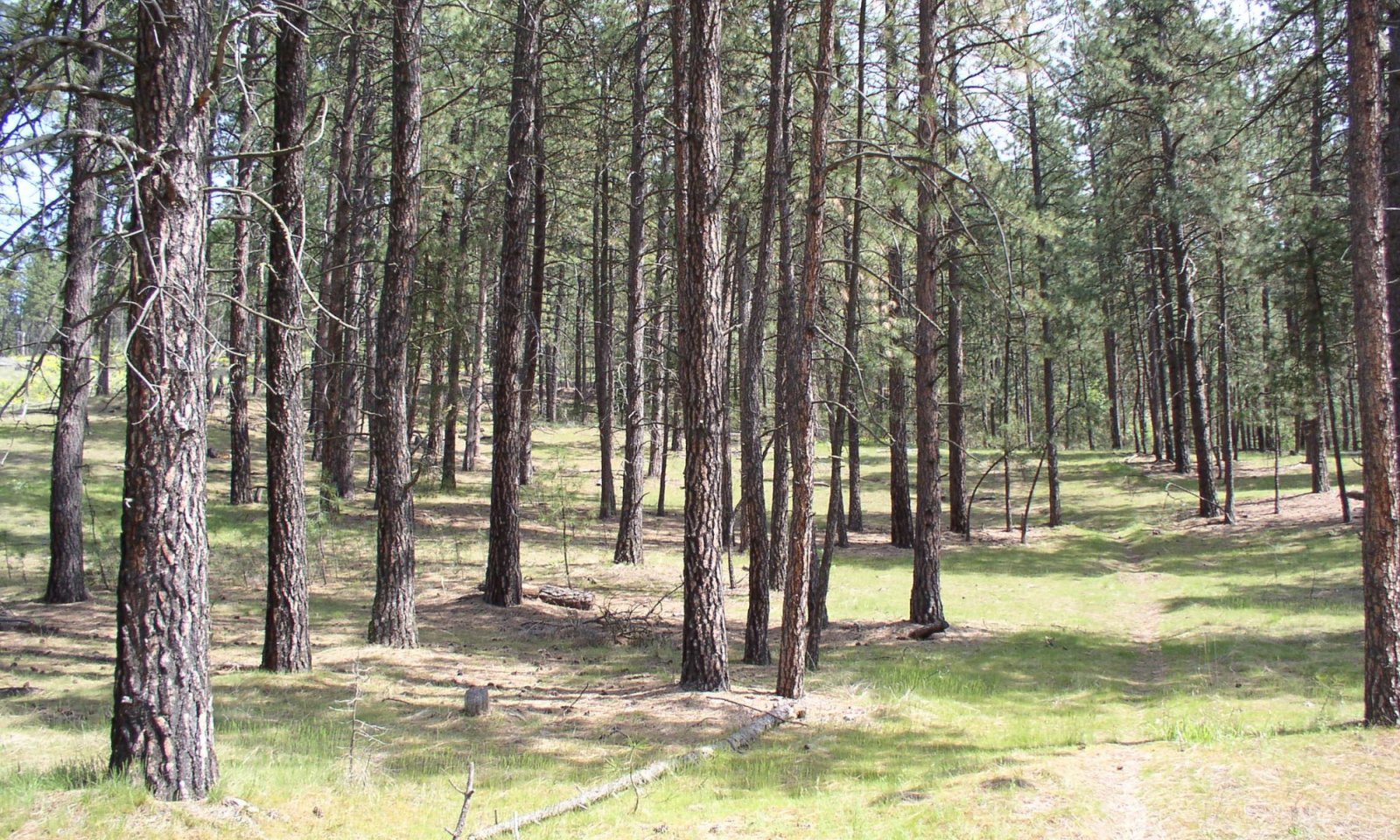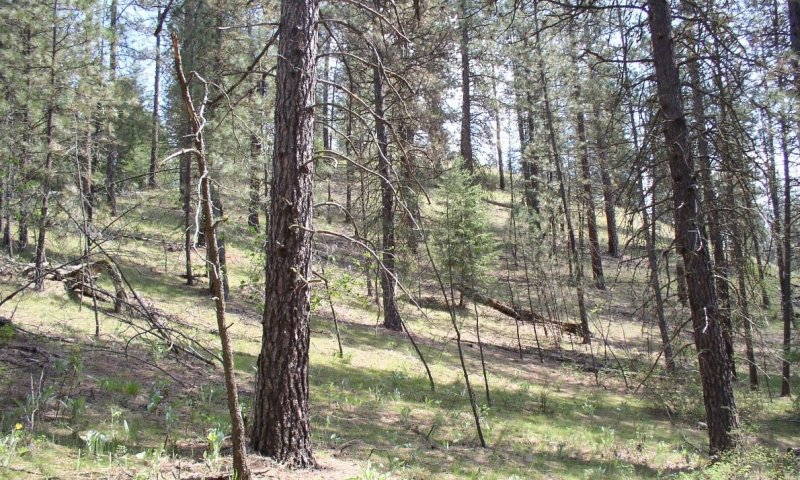
Ecological site group EX043AESG03
Warm, Dry, Hill Slopes and Terraces (Ponderosa Pine Warm Dry Grass) Pinus ponderosa / Pseudoroegneria spicata , Pinus ponderosa / Festuca idahoensis Pinus ponderosa - Pseudotsuga menziesii / Pseudoroegneria spicata
Last updated: 03/19/2020
Accessed: 12/18/2025
Ecological site group description
Key Characteristics
None specified
Provisional. A provisional ecological site description has undergone quality control and quality assurance review. It contains a working state and transition model and enough information to identify the ecological site.
Physiography
Modal LRU: 43A03 - Columbia-Colville Valleys
This LRU is composed predominantly of low to mid-elevation slopes of hills, outwash terraces and escarpments. The soils tend to be loamy mollisols, entisols and inceptisols with mixed ash surfaces. Till, outwash and some residuum or colluvium from metamorphic rock are the dominant parent materials. Soil climate is mesic temperature regime and xeric moisture regime with average annual precipitation around 490 mm (19 inches).
Other LRU where occurring: 44A01 - Spokane-Rathdrum Outwash Plains
43A02 - Western Selkirk Highlands
43A01 - Okanogan Plateau
Ecological Site Group Concept:
The data below describes the physiographic, climatic and other parameters for the Ponderosa Pine/ Dry Grass ES group as a whole. This vegetation alliance is widespread so a Core Concept for each parameter is also described.
See Appendix A for a finer division of the alliance based on selected soil features.
This ecological site is distinguished by a ponderosa pine / grass community on dry slopes or benches. Bluebunch wheatgrass dominates the understory on the drier slopes and Idaho fescue will be more prevalent on the moister landscapes like level benches. Ponderosa pine is the only tree species, except at higher elevations Douglas-fir can creep in without fire and be a minor stand component. With reoccurring ground fires, the landscape is a pine – grass savanna with scattered pine and dominant bunchgrass cover. With fire exclusion, pine seedling cohorts can survive, and a patchy pine woodland develops.
Physiographic Features
This ecological site occurs mainly on forested glaciated mountain back slopes, shoulders and foot slopes. It is found between 1,025 feet and 3,940 feet in elevation on east to northwest aspects. Slopes generally range from 10 to 35 percent, but can be found on slopes up to 100 percent.
Landscapes: Mountains, Foothills, Valleys
Landform: Mountain slopes, Hill slopes, Outwash terraces, Escarpments
Elevation Total range: 315 – 1,200m
(1,025 to 3,940 feet)
Core Concept: 605-840m
(1,980 to 2,755 feet)
Slope (percent): Total range: 0-100
Core Concept: 10-35 Water Table Depth 60- >200 cm
(24 to >80 inches)
Most water tables where present are perched
Flooding: Frequency: None
Duration: None
Ponding:
Depth (inches): 0
Frequency: none Duration: None
Aspect: Range: 70-203-335
Core Concept: 175-203-273
Climate
Climatic Features
During the spring and summer, a circulation of air around a high-pressure center brings a prevailing westerly and northwesterly flow of comparatively dry, cool and stable air into the region. As the air moves inland, it becomes warmer and drier which results in a dry season beginning in the late spring and reaching a peak in mid-summer. In the fall and winter, a circulation of air around two pressure centers over the ocean brings a prevailing southwesterly and westerly flow of air into the Pacific Northwest. This air from over the ocean is moist and near the temperature of the water. Condensation occurs as the air moves inland over the cooler land and rises along the windward slopes of the mountains or highlands. This results in a wet season beginning in October, reaching a peak in winter, then gradually decreasing in the spring.
The elevation within the LRU varies from approximately 1,000 feet in the lower river valleys to 3,500 feet over the Okanogan highlands. North-south ranges of mountains extending into southern British Columbia reach elevations of 4,000 to 5,000 feet within a few miles of the Okanogan River. The annual precipitation increases from 11 inches in the valley to 23 inches over some of the Plateau. Winter season snowfall varies from 30 to 70 inches. Both rainfall and snowfall increase in the higher elevations. Snow can be expected after the first of November and to remain on the ground from the first of December until March or April. The few snow survey reports available for elevation above 5,000 feet indicate six to eight feet of snow on the ground the first of April and four to five feet the first of May.
In January, the average maximum temperature is near 30° F and the minimum temperature is 15° F. Minimum temperatures from -10° to -20°F are recorded almost every winter and temperatures ranging from -25° to -42° F have been recorded in the colder valleys. In July, the average maximum temperature is 85° to 90° and the minimum temperature 45° to 50° F. Maximum temperatures reach 100° F on a few afternoons each summer and temperatures between 105° to 110° F have been recorded. Temperatures in the mountains decrease three to five degrees Fahrenheit with each 1,000 feet increase in elevation. The average date of the last freezing temperatures can be expected in the colder valleys by the first of September and before mid-October in the warmer areas.(from WRCC: Climate of Washington)
Mean Annual precipitation
Total Range: 245-755 mm
(10 to 30 inches)
Core Concept: 425-560 mm
(17 to 22 inches)
MAAT
Total Range 5.6-10.5 C
(42 to 51 F)
Core Concept: 7.4-8.6 C
(45 to 47 F)
Frost free period (days)
Total range: 95-145
Core Concept: 115-125
Climate Stations: CONCONULLY, , HUNTERS, INCHELIUM, JAY, MALOTT, MARBLE, MOUNT BONAPART, SULLIVAN LAKE NEAR, TONASKET, TONASKET (1), Midnite Mine, Wellpinit
Soil features
Representative Soil Features
This ecological site group is associated with several soil components. The soil components can be grouped into five soil great groups: Haploxerolls, Haploxerepts, Xeropsamments, Xerorthents, and Argixerolls. Soils in this ecologic site are very deep to moderately deep with available water holding capacities mostly equal to or greater than 6.7 cm (in 100cm). Most of these soils have developed in over till, outwash and residuum and colluvium from metamorphic rock that has some influence from Mazama tephra. The soils are mostly well-drained. Surface textures include ashy fine sandy loam, ashy silt loam, stony and/or ashy loam.
Soil series occuring in this ES group:
Bisbee, Boesel, Bong, Brincken, Dart, Dehart, Donavan, Dragoon, Garrison, Hesseltine, Hodgson, Hunters, Kartar, Koerling, Lacy, Maki, Malo, Marble, Marblespring, Muckamuck, Nez Perce, Northstar, Opportunity, Peka, Phoebe, Raisio, Reardan, Rufus, Scala, Seaboldt, Skanid, Spens, Springdale, Tekoa, Uhlig, Winthrop
Parent Materials:
Kind: Volcanic ash, Till, Outwash, Residuum, Colluvium, and small amounts of Glaciolacustrine material
Origin: Granite, Metasedimentary, other Metamorphic, Rhyolite and Quartzite
Surface Texture:
(1)Ashy Loam (2)Ashy Silt loam (3)Loamy Sand
(4)Stony Ashy Loam
(5)Ashy Fine Sandy Loam
(6)Gravelly Ashy Loam Subsurface Texture Groups: Loamy, Sandy Surface Fragments
Subsurface Texture Groups: Loamy, Sandy Surface Fragments
Vegetation dynamics
Ecological Dynamics of the Site
This reference site is located on very warm dry slopes with ponderosa pine the only tree species with an understory of mainly bluebunch wheatgrass, Idaho Fescue, and some needle and thread grass. Tree stocking is low with large open grown ponderosa pine and small amounts of sapling/pole size pine in understory. Frequent ground fires every 10-15 years kept pine regeneration low and perpetuated this condition with a dominant grass understory. With fire exclusion a mosaic of pine cohorts underneath the large pine survive and a patchy woodland develops. In addition, some woodland shrubs may establish, and an occasional Douglas-fir may be present. Stands in this altered state are subject to beetle kill and mistletoe infestation. Soils are mainly sandy loams or loamy sands. The main habitat types included in this ecological site are Ponderosa pine/bluebunch wheatgrass and Ponderosa pine/Idaho fescue. The bluebunch wheatgrass sites occur on the warmer drier slopes and the Idaho fescue sites occur on the lower slopes and more level terrain. Both habitat types have similar ecological processes as described above. The fescue sites will have more pine stand density due to a little more moisture and topographic position. Another habitat type this ecological site includes is Douglas-fir – Ponderosa pine/Bluebunch wheatgrass which will occur at higher elevations. The Douglas-fir will be subdominant to pine and woodland shrubs will be present.
Relationship to Other Established Classifications:
United States National Vegetation Classification (2008) – A3447 Ponderosa Pine / Herbaceous Understory Central Rocky Mt. Forest & Woodland Alliance
Washington Natural Heritage Program. Ecosystems of Washington State, A Guide to Identification, Rocchio and Crawford, 2015 – Northern Rocky Mountain Ponderosa Pine Woodland and Savanna
Description of Ecoregions of the United States, USFS PN # 1391, 1995 - M332 Middle Rocky Mt. Forest-Steppe-Coniferous Forest-Alpine Meadow Province
Level III and IV Ecoregions of WA, US EPA, June 2010 - 15r Okanogan – Colville Xeric Valleys & Foothills and 15s Spokane Valley Outwash Plains
This ecological site includes the following USDA Forest Service Plant Associations: PIPO/PSSP, PIPO/FEID, and PIPO-PSME/PSSP. (Williams et. al. 1995)
Major Land Resource Area
MLRA 043A
Northern Rocky Mountains
Subclasses
- F043AY509WA–Warm, Xeric, Sandy, Outwash Terraces and Plains (Ponderosa Pine/Dry Grass) Pinus ponderosa / Pseudoroegneria spicata , Pinus ponderosa / Festuca idahoensis
- F043AY510WA–Warm, Xeric, Loamy Hillsides, Low Available Water Capacity (Ponderosa Pine/Dry Grass) Pinus ponderosa / Pseudoroegneria spicata , Pinus ponderosa / Festuca idahoensis
- F043AY511WA–Warm, Xeric, Loamy Hillsides, Mixed ash surface (Ponderosa Pine/Dry Grass) Pinus ponderosa / Pseudoroegneria spicata, Pinus ponderosa / Festuca idahoensis
- F043AY512WA–Warm, Xeric, Loamy Mountainsides, ashy surface (Ponderosa Pine/Dry Grass) Pinus ponderosa / Pseudoroegneria spicata , Pinus ponderosa / Festuca idahoensis
Stage
Provisional
Click on box and path labels to scroll to the respective text.



